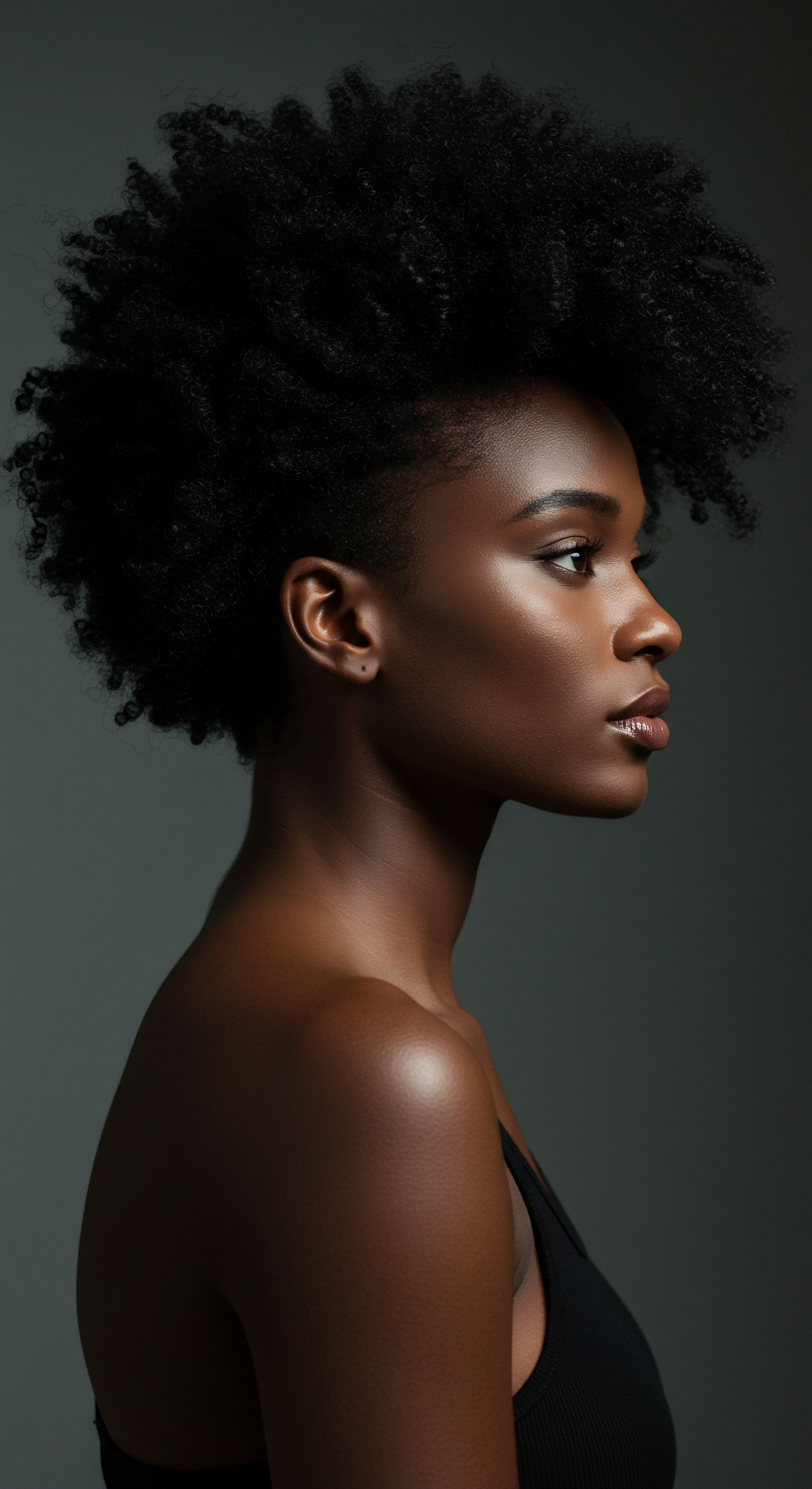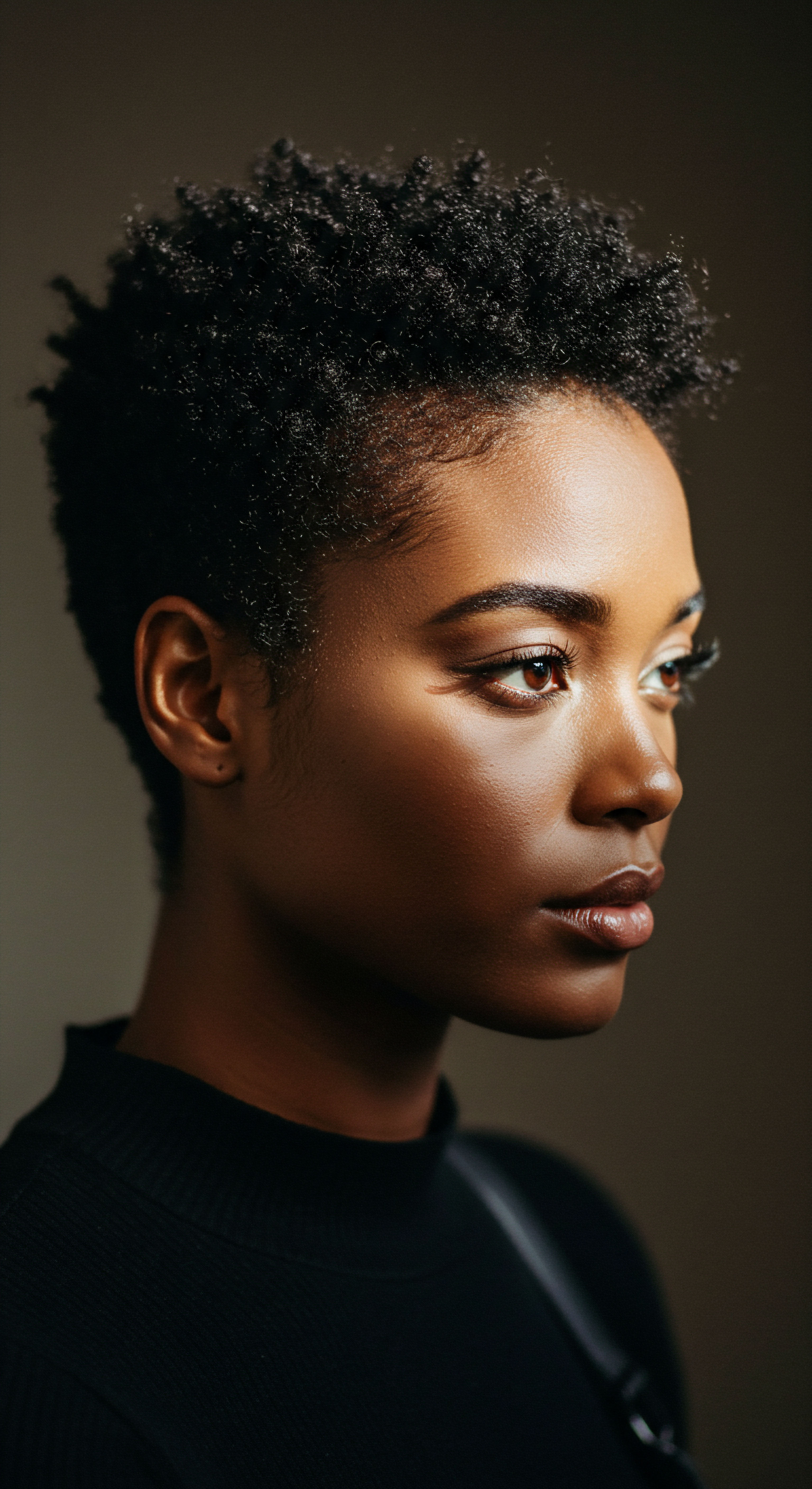
Roots
The dance of textured hair, with its coils, curls, and waves, is a profound expression of heritage and individual identity. Yet, beneath the visual poetry lies a practical consideration, a quiet challenge many experience daily ❉ the task of detangling. This isn’t merely about smoothing strands; it reaches into the very essence of hair health, longevity, and the personal ritual of care.
To truly understand the optimal implements for this delicate process, we must first look to the foundational principles of textured hair itself, its unique structure, and the forces that govern its behavior. Only then can we approach the question of tools with a grounded wisdom, discerning what truly serves the hair’s intrinsic needs.

The Architecture of Textured Hair
Textured hair, particularly Afro-textured hair, possesses a distinct morphology that sets it apart. Unlike straight hair, which tends to be round in cross-section, coily and kinky strands are often elliptical or flattened, twisting and turning along their length. This inherent curvature creates natural points of weakness and areas where strands readily interlock, forming tangles and knots.
The cuticle, the outermost protective layer of the hair shaft, with its overlapping scales, can also become raised, particularly when hair is dry or damaged, further contributing to friction and snagging. Understanding this microscopic architecture is the first step toward compassionate and effective detangling.
The unique helical shape of textured hair also impedes the natural distribution of sebum, the scalp’s protective oil, along the entire length of the strand. This often leads to dryness, which in turn can exacerbate tangling and increase susceptibility to breakage. The drier a strand, the more brittle it becomes, and the more likely its cuticles are to lift, creating a rough surface that clings to neighboring hairs.

Why Detangling Matters So Deeply
Beyond aesthetic considerations, detangling is a critical step in preserving the structural integrity of textured hair. When left unattended, tangles can progress into larger, more stubborn mats, leading to significant breakage during subsequent styling or cleansing. This loss of length and density can be disheartening, masking the hair’s true growth potential.
Understanding the unique architecture of textured hair, particularly its elliptical shape and inherent dryness, is fundamental to effective detangling.
Moreover, the very act of detangling, if approached without the proper tools and technique, can itself be a source of considerable mechanical damage. Repeated tugging and pulling, especially with unsuitable implements, can cause stress fractures along the hair shaft, leading to split ends and further weakening. This cyclical damage underscores the importance of a gentle, informed approach.
A study conducted by Kamath et al. highlighted a significant difference in hair breakage rates across hair types, observing that Afro-textured hair breaks approximately Ten Times Faster than straighter Caucasian hair when subjected to similar shear stresses experienced during combing or brushing. This accelerated fragility is linked to the unique morphology of Afro-textured hair, where tight curls and twists create concentrated points of stress when the hair is stretched or manipulated. This data underscores the profound impact of proper detangling practices and tool selection for preserving the health of textured hair.
| Hair Type Characteristic Elliptical Cross-Section |
| Impact on Detangling Creates natural points of interlocking, increasing tangle formation. |
| Hair Type Characteristic Tightly Coiled Structure |
| Impact on Detangling Impedes sebum distribution, leading to dryness and increased friction between strands. |
| Hair Type Characteristic Raised Cuticle Layer |
| Impact on Detangling Increases surface roughness, causing hairs to catch and snag on each other. |
| Hair Type Characteristic Lower Tensile Strength (when wet) |
| Impact on Detangling Greater susceptibility to breakage if detangled aggressively, particularly when saturated with water. |

Ritual
Stepping into the realm of daily care, the act of detangling transcends a mere chore; it becomes a ritual, a mindful interaction with our hair that shapes its vitality. The tools we choose for this intimate practice are not simply instruments, but extensions of our intent to nurture and protect. Here, we move from the fundamental understanding of hair structure to the practical application of wisdom, exploring how specific implements can transform a potentially arduous task into a gentle, even serene, part of our hair care regimen.

The Hand as a First Tool
Before introducing any manufactured implement, consider the inherent wisdom of the human hand. Finger detangling stands as one of the gentlest and most intuitive methods, particularly for those with very coily or delicate strands. The sensitivity of fingertips allows for precise navigation through knots, minimizing breakage by feeling for resistance and carefully separating strands rather than forcing them apart. This method is often the initial step in a comprehensive detangling routine, preparing the hair for the next phase of care.
Using fingers to detangle also allows for the even distribution of product, coating each strand with the necessary slip and moisture that facilitates the detangling process. This personalized approach respects the hair’s natural curl pattern and reduces the likelihood of disrupting its delicate architecture.

Wide Tooth Combs and Their Purpose
Following a thorough finger detangling, or for hair with looser curl patterns, a Wide Tooth Comb emerges as a venerable companion. The generous spacing between its teeth allows for tangles to be separated with minimal friction and pulling. Selecting a comb with smooth, rounded teeth is paramount, as sharp edges can abrade the cuticle and contribute to damage.
The design of the wide tooth comb respects the inherent volume and curl definition of textured hair. It glides through larger sections, gradually working through any remaining snags without stripping the hair of its natural shape. This tool is a cornerstone for wet detangling, where the hair is most pliable and receptive to manipulation when adequately lubricated with conditioner.

Flexible Bristle Brushes and Their Ingenuity
A more modern addition to the detangling toolkit is the Flexible Bristle Brush. These brushes, often featuring widely spaced, pliable bristles, are designed to contour to the head and move with the hair, minimizing resistance and preventing harsh tugging. Their innovative design often includes a ventilated back, allowing for quicker drying and reducing the buildup of product.
Flexible bristle brushes can be particularly beneficial for distributing detangling products evenly through the hair, ensuring every strand receives adequate lubrication. They are effective for both wet and damp detangling, providing a gentle yet thorough means of smoothing the hair and enhancing curl clump formation. When selecting such a brush, observe the flexibility of the bristles and the overall ergonomic design, ensuring it feels comfortable and intuitive in your hand.
The conscious selection of detangling tools, from fingers to wide tooth combs and flexible brushes, transforms a routine task into a nurturing ritual.
It is important to note that while some studies suggest hair is more fragile when wet, making dry detangling seem safer, others highlight that wet hair, when saturated with conditioner, becomes more malleable and elastic, reducing breakage by allowing strands to stretch before breaking. The optimal approach often involves a combination of methods, starting with gentle finger detangling on wet, conditioned hair, followed by a wide tooth comb or flexible brush, always working from the ends upward.

What Makes a Detangling Tool Truly Effective?
The effectiveness of a detangling tool transcends its material or shape; it lies in its ability to minimize mechanical stress on the hair shaft. This means prioritizing features that reduce friction, distribute product, and allow for a gentle, controlled process.
- Smooth Surfaces ❉ Any tool coming into contact with textured hair should possess exceptionally smooth surfaces, free from seams or rough edges that can snag and damage the cuticle.
- Generous Spacing ❉ Whether a comb or a brush, ample space between the teeth or bristles is crucial. This allows for tangles to pass through without being ripped or torn.
- Flexibility ❉ Tools that offer a degree of flexibility, either in their bristles or overall design, can adapt to the hair’s natural contours and density, providing a more forgiving detangling experience.
- Ergonomic Design ❉ A comfortable grip and balanced design reduce hand fatigue, encouraging patience and a more deliberate, gentle approach to detangling.
| Tool Type Fingers |
| Best For All textured hair types, initial detangling, sensitive scalps |
| Key Benefit Maximum control, minimal breakage, gentle separation |
| Tool Type Wide Tooth Comb |
| Best For Wet detangling, distributing conditioner, larger sections |
| Key Benefit Reduces pulling, preserves curl pattern, gentle on wet hair |
| Tool Type Flexible Bristle Brush |
| Best For Wet or damp detangling, product distribution, curl clumping |
| Key Benefit Adapts to hair density, minimizes tugging, enhances definition |

Relay
To truly comprehend the nuanced selection of detangling tools, we must venture beyond the immediate act of combing and consider the broader ecosystem of textured hair care, its historical context, and the scientific underpinnings that inform our choices. This journey requires a sophisticated lens, one that synthesizes cultural wisdom with modern scientific inquiry, revealing how seemingly simple tools are interwoven with complex biological realities and deeply rooted cultural narratives.

The Science of Slip and Hair Integrity
At the heart of effective detangling lies the concept of ‘slip’ – the smooth, frictionless glide that allows strands to separate without resistance. This is where the science of hair care products converges with the mechanical action of tools. Detangling conditioners and leave-in treatments are formulated with ingredients such as cationic surfactants, oils, and humectants, which coat the hair shaft, smooth the cuticle, and reduce the electrostatic forces that cause strands to cling together. When hair is sufficiently saturated with these agents, the task of detangling becomes significantly less damaging.
Research into hair detangling evaluation methods, such as those measuring frictional force during combing, has objectively demonstrated the impact of cosmetic ingredients. Studies have shown that treatments containing ingredients like rice bran extract can significantly alter the contact angle of the cuticle surface, bringing it closer to that of smooth, untangled hair and thereby increasing detangling efficacy. This scientific validation reinforces the importance of product choice as an essential companion to the detangling tool itself.

Is Dry Detangling Ever Truly Advisable for Textured Hair?
The debate surrounding wet versus dry detangling for textured hair has long been a point of contention within the community. While some anecdotal accounts favor dry detangling for perceived strength, scientific evidence suggests a more complex reality. Afro-textured hair, due to its unique morphology, exhibits greater fragility when wet. One perspective suggests that hair is more likely to have its bonds intact when dry, potentially making dry detangling safer for larger knots if done with extreme patience and product.
However, a contrasting view, supported by some studies, indicates that wet hair, when adequately saturated with a detangling product, gains increased malleability and elasticity. This enhanced elasticity allows the hair strands to stretch considerably before reaching their breaking point, a property not observed in dry hair. For many with coily and kinky textures, attempting to detangle dry hair can lead to significant breakage, as the brittle strands are less forgiving of manipulation.
The consensus among many natural hair experts and the practical experience of countless individuals points toward detangling on wet or damp hair, heavily coated with a conditioner or detangler, as the method that yields less breakage and greater ease. This approach capitalizes on the hair’s temporary increase in elasticity and the lubricating effect of products, creating an optimal environment for gentle separation.
The strategic use of detangling products is paramount, as they create the necessary ‘slip’ that protects the hair shaft during the mechanical action of detangling tools.

How Do Hair Care Practices Influence Tool Efficacy?
The effectiveness of a detangling tool is not isolated; it is profoundly influenced by the broader hair care regimen. Consider the historical context of Black hair care, where practices often evolved out of necessity and ingenuity in the face of societal pressures and limited product availability. The understanding of moisture retention, protective styling, and gentle manipulation has been passed down through generations, shaping contemporary approaches to detangling.
For instance, the practice of Pre-Pooing, applying a treatment before shampooing, has gained significant traction for textured hair. This step provides a protective layer, preventing the shampoo from stripping essential moisture and making the hair easier to detangle post-wash. When hair is pre-pooed, the detangling tools, whether fingers or a wide tooth comb, encounter less resistance, leading to reduced breakage. This synergy between preparatory treatments and tool selection is a testament to a holistic approach to hair health.
Furthermore, the choice of styling practices also impacts detangling frequency and ease. Protective styles, such as braids, twists, and buns, can minimize tangling by keeping strands contained and reducing exposure to environmental factors that contribute to knots. When these styles are taken down, the detangling process becomes a more significant undertaking, requiring patience and the right tools to navigate the accumulated shed hairs and interlocked strands.
- Pre-Poo ❉ Applying an oil or conditioner before shampooing creates a protective barrier, reducing moisture stripping and easing detangling.
- Sectioning ❉ Dividing hair into smaller, manageable sections allows for focused detangling, preventing re-tangling of previously worked areas.
- Product Saturation ❉ Liberally applying a detangling conditioner or leave-in ensures maximum slip, allowing tools to glide through hair with minimal friction.
- Starting at Ends ❉ Always begin detangling at the ends of the hair, working upwards toward the roots. This prevents pushing tangles further down the hair shaft.
| Condition Dry Hair |
| Impact on Detangling Increased friction, higher breakage risk for tightly coiled textures. Hair is less elastic. |
| Optimal Tool/Approach Not recommended for most textured hair; if necessary, use extreme gentleness and ample product. |
| Condition Wet Hair with Conditioner |
| Impact on Detangling Enhanced slip, increased elasticity, reduced friction. Ideal for detangling. |
| Optimal Tool/Approach Fingers, wide tooth combs, flexible bristle brushes. |
| Condition Hair with Product Buildup |
| Impact on Detangling Can create stickiness, reducing slip and increasing tangles. |
| Optimal Tool/Approach Clarifying pre-poo, then detangle with conditioner. |
| Condition Fine, Textured Hair |
| Impact on Detangling Prone to single strand knots and breakage from aggressive pulling. |
| Optimal Tool/Approach Emphasis on finger detangling, very soft flexible brushes. |

Reflection
The conversation surrounding detangling textured hair is far richer than a simple list of instruments. It is a dialogue between the innate wisdom of our bodies, the historical echoes of cultural practice, and the illuminating insights of science. The best tools for detangling textured hair are not just objects; they are conduits for a mindful approach, allowing us to engage with our strands not as a battle to be won, but as a delicate dance of care and understanding. As we continue to learn and evolve, our practices too will adapt, always seeking that harmonious balance where hair thrives in its natural splendor, unburdened and free.

References
- Curl Keeper. Wet vs. Dry Detangling ❉ The Ultimate Guide for Healthy Hair.
- Earthtones Naturals. Detangle Without Damage.
- Carol’s Daughter. How to Brush Curly Hair Without Disrupting Your Curl Pattern.
- Breuer, M. M. (1975). The tensile properties of human hair. Journal of the Society of Cosmetic Chemists, 26(9), 425-439.
- Khumalo, N. P. et al. (2010). Hair Breakage in Normal and Weathered Hair ❉ Focus on the Black Patient. Clinical, Cosmetic and Investigational Dermatology, 3, 1-6.
- Gathers, M. A. (2013). Historical Perspectives on Hair Care and Common Styling Practices in Black Women. Journal of Clinical and Aesthetic Dermatology, 6(11), 37-41.
- Science World. Ever Wonder About Detanglers?
- Hair Cuticle Care. The Complete Guide to Protecting and Strengthening Your Hair.
- Tavistock Training. Detangling the roots of racial representation in The Netherlands through the imagery of Black hair salon.
- The Natural Haven Bloom. So Should You Be Combing Your Hair Wet Or Dry? An Experiment.
- Rezende, M. C. et al. (2018). Detangling Hairwork ❉ A Study of Victorian Mourning Practices. University of Alberta.
- Lee, H. S. et al. (2020). Hair Detangling Evaluation Method Using Section Detangling Rate. Cosmetics, 7(3), 56.
- Rock & Ruddle. The Impact of Different Hairbrush Materials ❉ Choosing the Right Brush for Optimal Results.
- Byrd, A. & Tharps, L. L. (2001). Hair Story ❉ Untangling the Roots of Black Hair in America. St. Martin’s Press.
- Chéribé Beauty. 14 Best detanglers for black hair (2025 Review).
- Robbins, C. R. (2012). Chemical and Physical Behavior of Human Hair (5th ed.). Springer.
- Swift, J. A. (1999). A statistical analysis of hair breakage. II. Repeated grooming experiments. International Journal of Cosmetic Science, 21(5), 327-340.
- Odele Beauty. 6 Things Everyone Should Know About Black Hair History.
- Sherrow, V. (2023). Encyclopedia of Hair ❉ A Cultural History. Greenwood.
- Rock & Ruddle. The Surprising Truth About Your Hairbrush (And Why It Matters!).
- Lee, H. S. et al. (2020). Hair Detangling Evaluation Method Using Section Detangling Rate. ResearchGate.
- Lee, H. S. et al. (2020). Hair Detangling Evaluation Method Using Section Detangling Rate. DOAJ.
- Kamath, Y. K. et al. (2020). Defying Damage ❉ Understanding Breakage in Afro-textured Hair. Cosmetics & Toiletries, 135(1), 38-44.
- Wortmann, F. J. & Schulze, C. (2015). Comparing Hair Tensile Testing in the Wet and the Dry State ❉ Possibilities and Limitations for Detecting Changes of Hair Properties due to Chemical and Physical Treatments. Skin Research and Technology, 21(2), 220-227.
- Wortmann, F. J. & Schulze, C. (2015). Comparing hair tensile testing in the wet and the dry state ❉ Possibilities and limitations for detecting changes of hair properties due to chemical and physical treatments. PubMed.
- British Association of Dermatologists. Caring for Afro-textured hair.
- Trois For All. Detangling brush | Anti-crates.
- Abayomi, A. O. et al. (2022). The Genomic Variation in Textured Hair ❉ Implications in Developing a Holistic Hair Care Routine. Cosmetics, 9(5), 101.
- Healthline. Pre-Poo ❉ Types, Benefits, and How to Use, Plus DIY Recipes.
- NaturallyCurly. Don’t Try to Detangle Type 4 Hair Without These 4 Things.
- Miche Beauty. What Is Pre-Poo and Do You Really Need It?
- Aguh, C. & Maibach, H. (2016). Hair Aging in Different Races and Ethnicities. Journal of Clinical and Aesthetic Dermatology, 9(12), 24-31.
- Controlled Chaos Hair. What is Pre-Poo and Why You Should Be Doing It?
- Kurlify. Your Guide to Pre-Poo for Curly & Natural hair.
- Okoro, E. A. et al. (2016). Hair Breakage in Patients of African Descent ❉ Role of Dermoscopy. Journal of Pigmentary Disorders, 3(1), 1000213.
- Dia-Stron. Testing your Winter hair care products.
- Trüeb, R. M. et al. (2018). Types and characteristics of hair across different countries ❉ results. Clinical, Cosmetic and Investigational Dermatology, 11, 237-245.
- Carol’s Daughter. Ultimate Guide To Detangling Natural Hair.